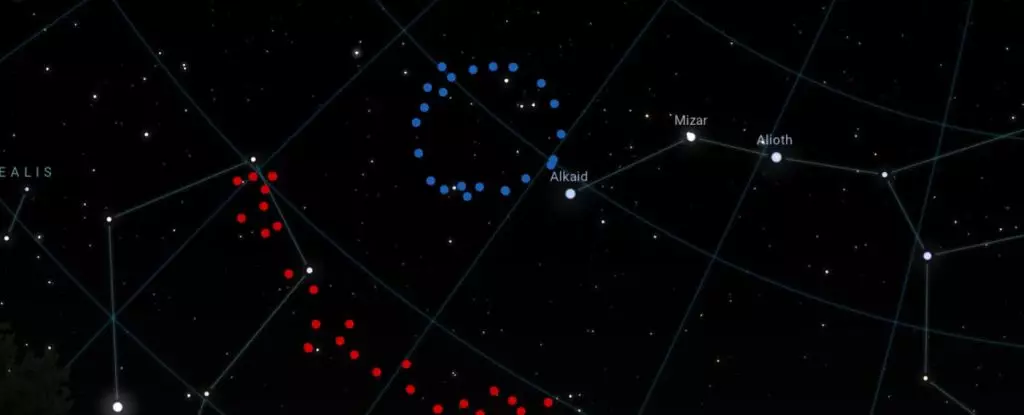In an astonishing revelation for modern cosmology, astronomers have encountered a colossal structure in the universe known as the Big Ring. This formation, which encompasses a staggering diameter of 1.3 billion light-years, challenges the long-cherished concepts surrounding the evolution of our cosmos. Spearheaded by astronomer Alexia Lopez from the University of Central Lancashire, this finding was unveiled to the scientific community during the 243rd Annual Meeting of the American Astronomical Society in 2024. The discovery comes on the heels of another perplexing cosmic structure found by Lopez and her team—the Giant Arc—suggesting an emerging trend of anomalies that necessitate a critical reassessment of our current models.
Breaking Down Conventional Models
The Big Ring’s existence raises fundamental questions regarding the standard model of cosmology, which has historically served as the backbone of our understanding of the universe’s structure. Lopez’s team highlighted that neither the Big Ring nor the Giant Arc fits neatly into the cosmological narrative we have cultivated over decades. Both structures defy conventional size constraints; current models suggest a theoretical capacity for structures to reach a maximum of approximately 1.2 billion light-years. The reality of these discoveries not only stretches the boundaries of our models but also poses daunting challenges that could redefine our fundamental cosmological principles.
The consternation surrounding these revelations is palpable. Lopez aptly articulated this dilemma, noting that, historically, cosmologists have expected a uniform distribution of matter across expansive distances in the universe. The emergence of extraordinarily large formations signals a dissonance that is difficult to explain using current theories. What does this mean for the Cosmological Principle, which mandates that, at a grand scale, the universe should appear homogenous regardless of the observational perspective?
What Lies Beyond Baryon Acoustic Oscillations?
The first instinct of astronomers when presented with a structure like the Big Ring might be to associate it with Baryon Acoustic Oscillations (BAOs)—massive, spherical configurations of galaxies produced by sound waves in the primordial universe. These BAOs, frozen in time, help provide context and scale to our cosmic observations. However, careful analysis proves that the Big Ring deviates markedly from this known phenomenon. Distinctly non-spherical and resembling more of a corkscrew-like shape, it transcends the category of BAOs, raising provocative questions about what this formation actually represents.
With BAOs typically averaging around one billion light-years in diameter, the existence of the Big Ring—both larger and oblong—forces astronomers to rethink the implications of such cosmic features. These revelations compel us to contemplate whether we might have misconceived the fundamental relationships between cosmic structures or, potentially, the properties of the universe itself.
Cosmic Strings and Topological Anomalies
Among the many theories attempting to elucidate the nature of the Big Ring, one compelling idea posits that these formations may be examples of topological defects known as cosmic strings. These hypothetical “wrinkles” in the fabric of space-time are thought to have knitting-like origins from the early universe’s rapid expansion. Although we currently lack substantial empirical evidence for the existence of cosmic strings, the theoretical models suggest a rich and intriguing avenue for exploration.
As researchers continue to investigate these cosmic anomalies, it is essential to keep an open mind about the potential alternative cosmological models that could encapsulate these peculiarities. Roger Penrose’s idea of conformal cyclic cosmology, for instance, proposes that the universe undergoes infinite cycles of expansion and retraction, allowing for the existence of novel structures. However, while this concept presents fascinating possibilities, it grapples with its share of theoretical dilemmas that must also be unpacked.
The Search for Answers
The apparent irreplicable nature of structures like the Big Ring means they could either signify a new chapter in cosmological studies or represent mere coincidental alignments of galaxies devoid of broader significance. The prospect of unearthing even more large-scale galaxy arrangements across the cosmos offers some hope in developing a deeper understanding of these revelations. Lopez rightly points out that the probability of finding structures on this scale had previously seemed implausible; she emphasizes our current comprehension might need a radical shift.
Indeed, intriguing possibilities lie ahead for cosmology, one that may redefine our approach to understanding the cosmos and its myriad complexities. As researchers delve deeper into the implications of these enormous structures, the need for a robust framework capable of accommodating anomalies becomes increasingly clear. The Big Ring is not merely a cosmic oddity; it is a portent of a revolution in our understanding of the universe, one that beckons the brightest minds in science to embark on an exploration that could reshape the very essence of our cosmic narrative.

